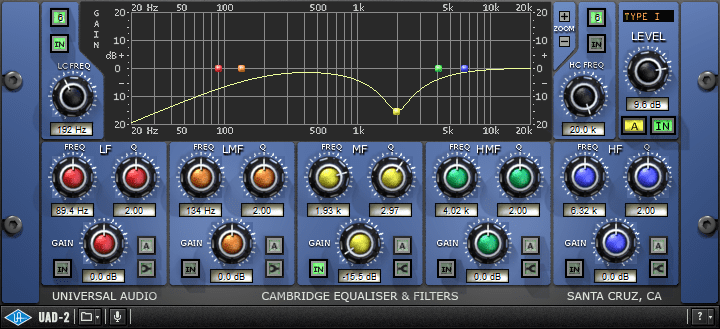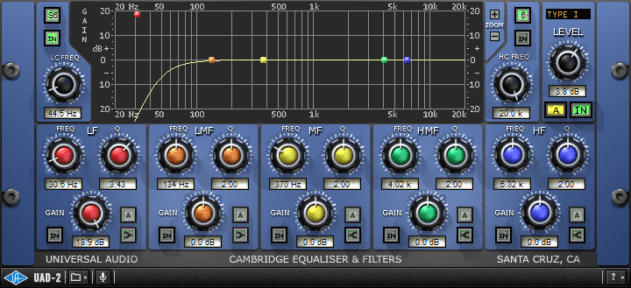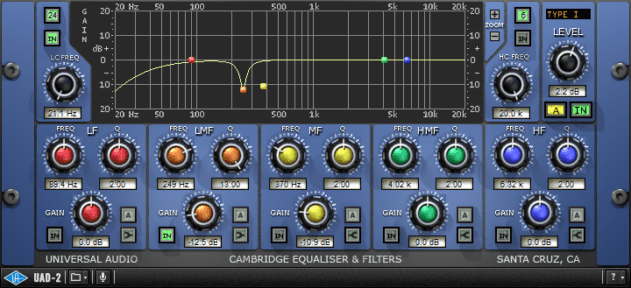EQ is one of the three fundamental tools used to shape the mix. Bruce Aisher explains how to use it to clean up a track.
Many tools are available to us when mixing a track, but one of the most important is EQ.
EQ can be used in all kinds of subtle (and not so subtle) ways, but at its most basic, it offers a highly effective way of cleaning up mix elements to help them sit together better.
One of the most important tasks when mixing a track is to make the most of the bandwidth we have available to us. That means making space for every element in a mix. EQ plays two main roles in this process.
The first is to make each of our elements sound good in isolation. That might mean subtly boosting the upper midrange of a vocal to increase presence or the low end of a synth part to give it more weight.
The second – and arguably even more important – use for EQ is to make space for all the elements to fit together. If multiple elements of a mix occupy similar frequency ranges and attempt to fit into the same space, the result will often sound muddy, muddled and unclear. It’s this process which we’re going to focus on in this walkthrough, starting with a bad mix and using subtractive EQing to clean it up.
Here’s the messy, cluttered mix which we’re going to tweak:
Audio PlayerIn this raw state, the mix is clumsy and muffled. Let’s get started cleaning it up…
Start At The Bottom
Addressing the low frequency elements is a good place to start. In dance music mixes the best place to start is usually with the kick drum.
Here’s our kick on its own:
Audio PlayerWe’ll use a high-pass filter EQ to remove the extreme low end and help provide extra headroom. (Click images to enlarge.)
Here we’ve rolled off the lowest sub-bass frequencies, which won’t be reproduced on most systems and fall below the limits of human hearing but still take up crucial bandwidth.
Here’s how the kick sounds after EQing:
Audio PlayerWe can come back to the kick if necessary, but for now we need to hear it with the bassline in order to get a fuller picture of what else is required.
Here’s the bassline on its own:
Audio PlayerAnd the unprocessed bassline with the processed kick:
Audio PlayerAs with the kick, let’s roll off the very low frequencies first. Next, we can use the EQ to notch out an area between approximately 200 and 250 Hz. In many cases we can make a cut like this to reduce muddiness in the low end without affecting the overall character of the sound.
Here’s how the bass sounds after we’ve applied our EQ:
Audio PlayerAnd how the processed bassline works with the processed kick:
Audio Player


05.24 PM
This is great! Thank you for all these awesome posts.
08.07 PM
Next you should do a similar process with compressors. So many new producers have no idea how to actually use one properly. The idea of using a compressor for a very specific reason seems to be amiss so often.
Anyway, awesome article!
04.47 AM
Simple , Precive, Effective.
Thanks a Lot
10.18 AM
Thanks a bunch, used the tip for eq’ing the kick on a track I just finished today and helped out loads! This site is the bees knees!
07.40 AM
Thanks! 🙂
07.44 AM
@ Gaffe: Did you read the article completly? 😀 attack magazine: “we haven’t applied any additional reverb or compression as yet (we’ll be covering how those processes relate to mixdowns in future walkthroughs).”
11.42 PM
Keep ’em coming, maybe some future garage-beats dissected/vocal eq?
12.39 AM
Great article for begginers, very good work 🙂 Please make one about EQ-ing vocals and fitting them into a track – it would be really appreciated! Cheers
12.56 AM
loading the sound demos only happens “reluctantly”. maybe a problem on my end… still worth checking though.
the content is great 🙂
04.29 PM
Excellent article, very helpful, thanks
10.38 PM
That was really really good. Thanks.
12.55 AM
Is there a rule for EQing specific sounds (like cutting the frequencies below 134 Hz for the kickdrum in the example)?
Or is it based on trial-and-error for every sound?
04.32 PM
Hey Bronco,
No rules for specific sounds I’m afraid; depends on the sound in question, on what it is doing in the mix, and on other sounds in the mix too. Most of all, it depends on what you are trying to achieve from both the sound and the mix.
There are some good practice guidelines that many producers would stand by: try to cut rather than boost; if you do boost, boost ‘wide’; and it’s often worth cutting frequencies from a sound that aren’t doing anything useful (‘topping and tailing’).
That said, in electronic music anything goes – and there are plenty of rule breakers out there making great records.
We’ll be doing more on EQ in the coming weeks. Watch this space.
Dave@Attack
06.55 PM
Thanks for your reply, Dave. It’s helpful to me =)
And keep up your great work, I’m sure that everybody who knows this website really appreciates your work.
02.35 PM
HI I have a similar question regarding EQ on Kick and Bass. Do we have to use a low latency EQ for that? and what about the Q of the lowcut should it be 6 db/oct or more? Some sites say that 6DB/Oct or even 12DB/Oct is better to use because of ringing on the cutoff slope Im on logic 9 btw what is your advice on this? I see that you use the UAD Cambridge EQ where as I like to use FabFilter Pro-Q as I don’t have UAD hardware
Thanks in advance
Best Regards,
reDJesh
12.03 AM
This is great info is well explained in an easy way to understand for people starting in music.
To me is about following all that info as a reference and also get creative,at the end the main rule is,there are no rules and the end result is what matters as far the producer can get the workflow
02.25 PM
I basically just want to hug you guys every time I read one of your excellent tutorials.
05.40 AM
Very helpful article. It’s helped me get my head round the basics. Thanks!
11.53 AM
OK, but this tutorial is useless because the bass used is played by a keyboard instead of a real bass. The drums used in these sound filesis a drum computer. Only tutorials using proper instruments are interesting
11.25 AM
Great stuff!! Thanks.
09.09 AM
If I could only get at the level of your ‘messy’ mix I would be grateful!
01.20 PM
Want to mix better and be able to pinpoint problem frequencies by heart? Try this https://www.trainyourears.com/mixlikeapro
08.28 PM
Great walk through although it would make a lot more sense to learners if a sprectrum analyzer was included for visual reference.
Cheers
03.52 PM
wow great ! i am still a baby in mixing .this one now boost my mixing up. nice one